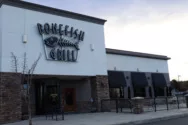
Home » This family’s roots run deep on Red Mountain
A vintage legacy
This family’s roots run deep on Red Mountain

This year marks the 50th anniversary of the first vineyard to plant grapes on Red Mountain. Kiona Vineyards remains a family-run operation, now in its third generation. From left, Scott Williams, Ann Williams, John Williams, JJ Williams and Tyler Williams.
Courtesy Travis GillettJune 12, 2025
John and Ann Williams and Jim and Patricia Holmes were the first to plant vines on Red Mountain. Today, it’s a celebrated wine area that’s home to its own federally-recognized growing region.
Kiona Vineyards, the winery they founded, celebrates its 50th anniversary this year and the third generation of the Williams family plans to stick around for 50 more.
Brothers JJ Williams, general manager, and Tyler Williams, winemaker, grew up on Red Mountain and worked in the vineyards, but it wasn’t until later that they came back with degrees and qualifications to take up their parents’ and grandparents’ work.

The tasting room at Kiona has sweeping views of vineyards and vistas.
| Photo by Nathan FinkeStarting from scratch
John and Ann Williams, JJ and Tyler Williams’ grandparents, planted the vineyard with their friends Jim and Patricia Holmes in 1975.
After working with an experimental vineyard through Washington State University’s Prosser horticultural extension, John Williams and Jim Holmes decided to plant their own vineyard.
They found a cheap site on the edge of town, but it wasn’t just the price that was appealing. “This site checked all the boxes. It has the nice southwest exposure. The wind is right, the soil is right. It wasn’t random that they picked a spot, they knew it would be good, and it was affordable,” JJ Williams said.
He described it as a “scrappy” move – the friends were material scientists with seven children at home between the two families. They didn’t have large funds from other work to kick-start their vineyard, but they bought the undeveloped land anyway. They had to dig a well, put in power and bring in a road.
At the time, there weren’t many wineries in Washington, and white wines were expected to be profitable since they better tolerated cold winters.
But while the two families planted a third of their vineyard with riesling and another third with chardonnay, both white wine grapes, they dedicated the last third of their vineyard to cabernet sauvignon, a red wine grape. Not only did the grapes survive, they thrived.
That wine was “something nobody was drinking or buying or really even making in the Pacific Northwest,” JJ Williams said. “So if you fast forward to 2025, Red Mountain is considered by the wine cognoscenti to be one of the world’s premier cabernet sauvignon-growing regions.”
The Williams and Holmes families parted ways in the ’90s, when the Williams family bought the Holmes family’s shares in Kiona, and the Holmes family bought out the Williams family’s shares in the neighboring Ciel du Cheval vineyard.
Award-winning wines
Planting cabernet sauvignon in 1975 was a key move. “It was that planting that kind of made Washington state as a whole realize that Cabernet Sauvignon could indeed be a shining example of red wine,” Tyler Williams said.
As Kiona grew from 10 acres in 1975, to 272 acres across five different vineyards today –Kiona Estate, Heart of the Hill, Ranch at the End of the Road, Sunset Bench and Artz Vineyard – the number of acres dedicated to cabernet sauvignon has grown as well. The variety now makes up about 60% of Kiona’s total acreage. Another 8% is planted with merlot, another red wine grape, and the remaining acres are populated with 18 more varieties of wine grapes.
Kiona’s award-winning wines have received numerous accolades over the years, from high ratings to inclusion in numerous wine roundups, and Red Mountain has gained a reputation for being high-end in part because of Kiona, JJ Williams said.

It took more than their family name for general manager JJ Williams, left, and winemaker Tyler Williams to land their current roles. The brothers went afield to earn the qualifications needed to return as leaders of Kiona Vineyards.
| Courtesy Shawn LinehanA family affair
The Kiona operation continues to be a family affair – in addition to the sacrifices of JJ and Tyler Williams’ grandparents, their parents, too, “dedicated their young careers and their young marriage to an uncertain industry in an uncertain time and turned it into a viable business,” JJ Williams said.
Their parents and both sets of grandparents each live within a mile of the vineyards, and John and Ann Williams are both still living.
But for JJ and Tyler Williams, returning to run Kiona’s operations wasn’t just about their family name.
Their parents “made it clear that we couldn’t just mosey in because we had the right last name and take over, unless we were uniquely qualified to help the business in what the business needed,” JJ Williams said. “So we both kind of went off and became what Kiona needed us to be, and picked sides of the business that I think that we … had a good skillset for.”
Tyler Williams earned a degree in biology from Gonzaga University and got into winemaking while doing summer jobs working for neighbors on Red Mountain. He spent several years making wine around the world before coming back to Washington, where he got a master’s degree in wine science from Washington State University. He came on as Kiona’s winemaker in 2019.
JJ Williams went to business school and sold wine in Seattle before returning to Kiona in a sales position, eventually moving into a more general manager role.
While the brothers are in their 30s, relatively young in the wine industry, their roots run deep. Growing up, they lived 10 steps from the vines and would work in the vineyard, pulling weeds, digging ditches and more.
The Williams family is still actively involved in operations, too. “Tyler and I have lots of insight and experience at this point, but it would also be unwise to ignore the decades of institutional knowledge at our disposal, right?” JJ Williams said.
JJ Williams has two kids, ages 13 and 9, who are a little too young yet to think about being a part of the family business, he said.

The wine barrel room at Kiona.
| Photo by Nathan FinkeHalf a century
A team of 40 works at Kiona, between the vineyards, the winery, the tasting room and sales. Kiona’s wines are sold in 40 states and internationally, and the vineyard supplies grapes to about 60 other wineries. The winery has no debt and no investors, and demand for Kiona’s grapes continues to grow.
JJ Williams said their goal is for the company to last 100 years, still owned and operated by the family, and they’re halfway there.
Kiona’s 50 years have seen the creation of the Red Mountain American Viticultural Area, or AVA, in 2001. The Red Mountain AVA is part of the larger Yakima Valley AVA and is one of 21 designated AVAs in Washington.
More than 25 vineyards share the Red Mountain AVA, and for JJ Williams, it’s important for the whole mountain to be successful together.
Part of that success can come in the form of agritourism. “People care about where things come from, and getting out of the city and out of the strip mall and out of the parking lot,” he said. “… That’s a trend that we are well positioned to take advantage of.”
While visitors to Red Mountain used to be about half from the Tri-Cities area and half from Seattle around 20 years ago, JJ Williams said that now, about 40% of their visitors are not from the Pacific Northwest, including international visitors.
He said it’s intentional to come to Red Mountain: “It’s a little bit out of the way. You don’t just stumble upon this spot.”
In honor of the vineyards’ 50 years, the winery is releasing a 50th anniversary wine, a 2021 Estate Red Mountain Cabernet, which features a redesigned label from the ’80s and retails for $45.

Kiona winemaker Tyler Williams.
| Photo by Nathan FinkeThe Williams brothers honor their family’s legacy by overseeing every step of the winemaking process – from vineyard to bottle, an increasingly rare commitment in a world full of large-scale operations.
“Tyler and I are making a tangible thing that you can hold in your hand, and we’re responsible for it from start to finish,” JJ Williams said.
Agriculture + Viticulture
KEYWORDS June 2025
Related Articles
Related Products





